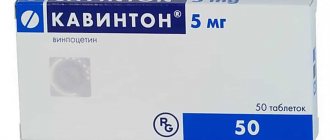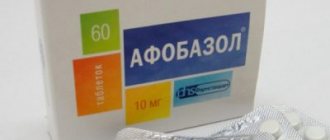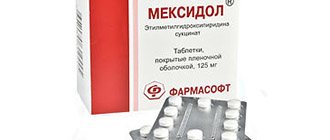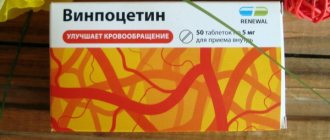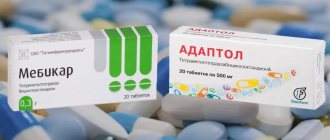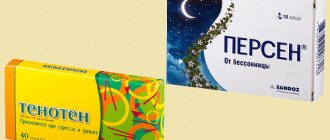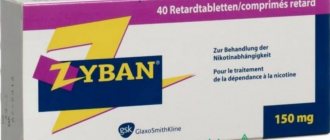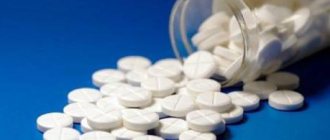pharmachologic effect
Manufacturer: numerous Russian and foreign
Release form: tablets, injection solution
Active ingredient: Vinpocetine
Vinpocetine 5 mg and Vinpocetine forte 10 mg are nootropic and psychostimulant drugs.
The main pharmacological properties are the following:
- improvement of metabolism in the brain;
- normalization of blood rheology;
- stimulating blood flow in the brain;
- reducing the effect of toxins on the functioning of the nervous system;
- neuroprotective properties;
- increase in ATP content in neurons;
- increased transport of glucose to nerve cells and fibers;
- antioxidant effect;
- reduction of blood viscosity due to inhibition of platelet aggregation;
- reduction of vascular resistance in the brain;
- improving blood transport to areas with ischemia and hypoxia;
- slight drop in pressure.
The complex effect on the body ensures the rapid onset of effects from the use of Vinpocetine and expands the scope of application.
Indications for use of Vinpocetine
The drug is prescribed for diseases of various areas:
- Neurological - encephalopathy with cognitive dysfunction, dizziness, headaches, acute disorders of blood flow in the brain, consequences of head injuries, atherosclerotic damage to cerebral vessels.
- Otolaryngological - hearing loss, especially in the elderly, Meniere's disease, hearing loss of various origins, dizziness due to damage to the hearing aid.
- Ophthalmological - vascular eye pathologies, atherosclerotic degenerative changes, consequences of vasospasms, vascular occlusion, secondary glaucoma.
Vinpocentine is prescribed in the complex therapy of these pathologies after examining the patient and assessing his condition.
Vinpocetine - instructions for use
Vinpocetine tablets are used orally. Injectable forms of the drug are produced in ampoules. Doses and dosage regimens are selected by the doctor, taking into account the underlying disease and condition of the patient.
The medication is not prescribed to patients who are allergic to the components of the medication, or in childhood.
During pregnancy and lactation, the drug is used to a limited extent and only under the supervision of a doctor.
Possible side effects include:
- dyspepsia,
- swelling of the conjunctiva,
- headaches and dizziness,
- hypotension,
- weight gain,
- neurological disorders,
- rash,
- dermatitis,
- arrhythmias,
- myocardial infarction.
These disorders develop with irrational and very long-term use of Vinpocetine. Compliance with the dose is the only prevention of complications.
Dosage of Vinpocetine tablets
The drug is taken orally from 1 to 2 tablets three times a day. The duration of treatment is selected individually depending on the severity of the disease.
Dosage of injection forms
Vinpocetine in 5 mg/ml ampoules is administered only intravenously. The average dose per day is 20 mg.
How to take Vinpocetine: before or after meals
The tablets should be taken after meals. Wash down with at least 100 ml of clean water at room temperature without gas. The tablet is swallowed whole, do not crush or chew.
A decrease in the effectiveness of the drug may occur if there are violations of the rules for taking Vinpocetine, which are indicated in the instructions for use.
Methods of therapy and dosage from the instructions for Vinpocetine
Tablets for oral administration are prescribed at 5-10 mg, up to 3 times a day. The therapeutic regimen depends on the type of current disease and the severity of the clinical picture.
In an injection solution, the drug is administered intravenously, the maximum single dose does not exceed 20 mg. Injections are used in acute conditions; if therapy in the first days did not cause unusual reactions in the body, then the initial volume is increased for 3-4 days to 1 mg per kilogram of weight. The duration of treatment is 2 weeks.
Accidental increase in the dosage recommended by the instructions provokes the appearance of side effects in the form of allergies, heart rhythm disturbances, sleep problems, headaches and dizziness. To suppress clinical manifestations, the patient's stomach is washed and one of the available sorbents is given: Smecta, activated carbon (1 tablet for every 10 kg of weight). Subsequently, symptomatic therapy is carried out.
Vinpocetine analogs
The drug is produced by various pharmaceutical companies. Its composition and release forms are completely identical. The only differences are in manufacturers and costs. The most popular Vinpocetine on the market is from the following companies:
- Gedeon Richter, Hungary,
- Sintez, Russia,
- Obolenskoye FPO, Russia,
- Kanonpharma, Russia,
- Pharmproject,
- Izvarino,
- North Star,
- Welfarm.
Direct imported analogues and substitutes for Vinpocetine are Cavinton, Cavinton forte 10 mg in different release forms and dosages. Manufacturer: Gedeon Richter, Hungary. They are original drugs for which all the necessary studies on safety and effectiveness have been carried out.
In some cases, doctors replace Vinpocetine with analogues of the drug, including the new generation. Such products differ in composition, release forms and manufacturers, but have a similar effect on the body. Analogues of the drug include the following:
- based on citicoline - Ceraxon, Somazina;
- containing Phenibut - Noofen;
- combination drugs based on vinpocetine, piracetam and cinnarizine - Vinpotropil, Phezam, Omaron;
- medications containing piracetam - Nootropil, Lucetam;
- Picamilon;
- drugs based on cinnarizine - Stugeron;
- analogues that contain betahistine - Betaserc, Vestibo, Tagista;
- gama-aminobutyric acid - Aminalon, Olatropil;
- Glycine;
- Cortexin;
- Mebicar;
- Noopept;
- pramiracetam (new generation) - Pramistar;
- Cerebrolysin;
- Pantogam;
- new generation idebenone as part of the Noben analogue;
- pentoxifylline, which is contained in Trental;
- products with a combined composition that affect the nervous system - Cytoflavin, Vasobral, Actovegin;
- analogues based on Ginkgo Biloba - Tanakan, Bilobil;
- active substance nicergoline and drugs based on it - Sermion, Niceromax.
List of Vinpocetine analogues with prices.
| Name | Active substance | Manufacturer | Release form | Cost of minimum packaging and dose |
| Vinpocetine | Vinpocetine | Gedeon Richter | Pills | From 100 rub. |
| Vinpocetine | Pharmproject | From 55 rub. | ||
| Vinpocetine | Borisov plant | Ampoules 2 ml | From 75 rub. | |
| Cavinton | Gedeon Richter | Pills | From 109 rub. | |
| Cerakson | Citicoline | Ferrer, Spain | Oral solution | From 680 rub. |
| Noofen | Phenibut | Olaipharma | Capsules | From 980 rub. |
| Vinpotropil | Vinpocetine, Piracetam | Canonpharma | Pills | From 390 rub. |
| Omaron | Piracetam, Cinnarizine | Hemofarm | From 130 rub. | |
| Nootropil | Piracetam | UCB | From 250 rub. | |
| Picamilon | Picamilon | Pharmstandard | From 95 rub. | |
| Stugeron | Cinnarizine | Gedeon Richter | From 180 rub. | |
| Tagista | Betagistine | Hemofarm | From 80 rub. | |
| Betaserk | Betagistine | Veropharm | From 555 rub. | |
| Aminalon | Gamma-aminobutyric acid | Borisovsky | From 130 rub. | |
| Glycine | Glycine | Biotics | From 30 rub. | |
| Cortexin | Polypeptides | Geropharm | Powder for preparing solution | From 1300 rub. |
| Noopept | Noopept | Pharmstandard | Pills | From 340 rub. |
| Pantogam | Hopantenic acid | Vips-Med | From 370 rub. | |
| Noben | Idebenon | Binnopharm | Capsules | From 550 rub. |
| Trental | Pentoxifylline | Sanofi | Pills | From 570 rub. |
| Vasobral | Ergocryptine, Caffeine | Pharmstandard | From 970 rub. | |
| Cytoflavin | Amino acids | Polisan | From 400 rub. | |
| Tanakan | Ginkgo biloba | Bofur | From 600 rub. | |
| Sermion | Nicergoline | Pfizer | From 520 rub. |
Vinpocetine and Cavinton - which is better and more effective, what is the difference
Manufacturer: Gedeon Richter, Hungary
Release form: tablets, dispersible tablets, ampoules
Active ingredient: Vinpocetine
Cavinton and Vinpocetine are complete analogues with the same composition. The clinical effects of using the drugs are the same. According to some doctors, Cavinton, being an original drug, exhibits higher efficiency and better tolerability.
Cavinton dosage: 1-2 tablets three times a day after meals or 20 mg per day for injection forms. These analogues are not intended for children. Safer drugs should be selected for their treatment.
Differences between analogue drugs in manufacturers. Cavinton is an imported analogue of Vinpocetine in tablets and injections, its price is higher.
What is the difference between Cavinton and Vinpocetine?
A good substitute for Vinpocetine, the analog Cavinton, which has the same composition and mechanism of action, but a higher cost, is produced by another manufacturer (Hungarian).
The active component in Cavinton is Vinpocetine, which has the ability to improve metabolic processes, dilate blood vessels, and reduce the risk of blood clots. This property is considered important for patients with vascular pathologies or those who are at risk of developing a stroke or heart attack.
When choosing which is better between Cavinton and Vinpocetine, it is important to pay attention to the content of additional components of the medicine. As part of the analogue, they are safer, which reduces the number of contraindications and improves tolerability.
Cavinton and Vinpocetine have the same indications for use, but the price of the analogue is three times higher. Thus, the price of Cavinton is about 250 - 300 rubles per pack of 10 tablets, and the cost of Vinpocetine does not exceed 60 rubles.
If you look at the reviews, you can note that the foreign analogue Cavinton is much better tolerated. When choosing between two medications, doctors often prescribe Cavinton, since during the production process, all components undergo deeper purification, which minimizes the risk of side effects.
[t_price foo=”cavinton”]
Vinpocetine or Piracetam - which is better?
Manufacturer: Ozone, Grotex, Obolenskoe
Release form: tablets, capsules, injection solutions
Active ingredient: Piracetam
Synonyms: Lucetam, Nootropil, Piramem, Stamin, Pyrabene
Piracetam and Vinpocetine belong to the group of nootropic drugs. Analogs differ in composition, mechanism of action, manufacturers, and release forms.
Differences between analogue drugs explain the difference in indications for use. For Piracetam, the main action is aimed at correcting cognitive functions. Vinpocetine, in addition to correcting cognitive functions, is widely used in neurology for dizziness, blood circulation disorders, including those due to cervical osteochondrosis, injuries and other pathologies. The speed of onset of effects is higher with Piracetam and its analogues.
Piracetam dosage: daily dose from 1.2 g to 2.4 g orally or intravenously. According to reviews from patients and doctors, the drug is well tolerated. Not prescribed for children. Elderly dose adjustment is not required.
Piracetam or Vinpocetine – which is better?
An analogue of Vinpocetine is Piracetam, which is a synthetic nootropic drug for the treatment of neurological diseases. Available in tablets and injection solutions, it can be prescribed to children and adults.
The basis of the drug is piracetam - it stimulates metabolic processes in parts of the brain, increases the synthesis of phospholipids and RNA. Application allows you to increase memory, facilitate the learning process, and improve mental performance. The main indications for the use of Piracetam are the following conditions:
- consequences of stroke;
- comatose states;
- vascular diseases;
- depressive disorders;
- cerebral palsy;
- Parkinson's disease.
Piracetam is prescribed not only for neurological diseases, but also for mental disorders, as well as conditions in which there is a decrease in intellectual abilities.
Piracetam differs from Vinpocetine not only in composition, but also in some effect after use. Therefore, without first consulting a doctor, replacing one medicine with another is strictly prohibited. Similarities between medications in affordable prices. So the price for Piracetam ranges from 50 to 100 rubles per package.
[t_price foo=”piracetam”]
Vinpocetine or Cinnarizine - which is better?
Manufacturer: Sopharma, Atoll
Release form: tablets
Active ingredient: Cinnarizine
Synonyms: Stugeron, Cinazine, Cinnarizine-forte, Cyrizine, Vertizine
Cinnarizine and Vinpocetine are analogues in action - both drugs exhibit nootropic properties. They are used orally to treat a number of diseases specified in the instructions for use.
Cinnarizine is characterized by specific indications for use, which include disorders of not only cerebral blood flow, but also peripheral ones. This makes it possible to use the analogue for the treatment of varicose veins, thrombosis, trophic ulcers, and paresthesia.
Dosage of Cinnarizine: 1-3 tablets three times a day, depending on the nature of the disease.
Cinnarizine or vinpocetine – what to choose
Cinnarizine is a nootropic drug that improves blood circulation in parts of the brain and increases mental performance. Cinnarizine and Vinpocetine have similar effects, are included in the same price category, but differ in composition and release form.
One tablet contains 25 mg of Cinnarizine, which is the basis of the medicine. You can buy the drug in a single form - tablets for oral administration. The mechanism of action is aimed at dilating blood vessels and improving blood flow in the peripheral tissues of the brain.
Cinnarizine is used in the symptomatic treatment of neurological pathologies, including:
- cerebrovascular insufficiency;
- vestibular disorders;
- migraine prevention;
- diabetic angiopathy;
- cardiac ischemia.
Indicated for frequent headaches, tinnitus, frequent dizziness, or decreased memory and concentration. Unlike Vinpocetine, Cinnarizine can be prescribed to children over 5 years of age.
Contraindications for use include pregnancy, allergies to the composition, galactosemia, acute vascular pathologies.
The dosage depends on the diagnosis. Cinnarizine is a domestically produced drug and has an affordable price that does not exceed 50 rubles. per pack of 50 tablets.
[t_price foo=”Cinnarizine”]
Vinpocetine or Mexidol - which is better and more effective, what is the difference
Manufacturer: Zdorovye, Russia
Release form: tablets, solution for infusion, ampoules
Active ingredient: Ethylmethylhydroxypyridine succinate
Synonyms: Armadin, Dinar, Mexiprim, Neurotropin, Elfunat
Mexidol is a complex analogue of Vinpocetine, which affects not only blood flow in cerebral vessels, but also improves metabolic and energy processes in the body. The range of indications for use of the drug is wider and has differences: cardiac ischemia, asthenia, neuroses.
The doctor selects the remedy that is most suitable for the patient after collecting an anamnesis and making a diagnosis. Positive reviews from patients indicate the high effectiveness of the drug as a nootropic agent.
Both analogues are intended for both internal use and intravenous administration. Mexidol dosage: from 125 to 250 mg of the drug per day. Vinpocetine and Mexidol are not used in children due to insufficient safety studies.
Vinpocetine or Phezam - which is better?
Manufacturer: Actavis
Release form: capsules
Active ingredient: Piracetam, Cinnarizine
Synonyms: Omaron
Phezam is a more expensive analogue of Vinpocetine. The composition of the drugs is different, but they are united by a similar nootropic effect on the body. Also, analogues have different manufacturers and release forms. The similarity of indications and contraindications allows us to consider it a full-fledged substitute for Vinpocetine.
Dosage of Phezam: from 1 to 3 capsules orally three times a day after meals. The drug is not used in children.
Vinpocetine
The drug vinpocetine belongs to the group of correctors of cerebral circulatory disorders. The drug has a vasodilating, antiaggregation, antihypoxic effect, and improves cerebral circulation. It is used mainly for insufficient blood supply to areas of the brain, as well as for vascular diseases of the retina and choroid (the morphological similarity of the blood vessels of the brain and eye makes it possible to use vinpocetine in both cases).
Vinpocetine blocks the action of the phosphodiesterase enzyme, as a result of which the concentration of cyclic adenosine monophosphate in the cells increases, which, in turn, entails a decrease in the content of calcium ions in the cytoplasm of smooth muscle cells and relaxation of muscle fibers. Vinpocetine combines both vascular and metabolic effects. The first is supported by the drug’s ability to increase the lumen of blood vessels in the brain, stimulate blood flow primarily in ischemic areas and solve “supply” problems by improving the mechanisms of oxygen delivery to the brain. The role of vinpocetine in metabolic processes is no less important: it promotes the utilization of glucose, increases the concentration of catecholamines in the central nervous system, and “ignites” the metabolism of the neurotransmitters norepinephrine and serotonin in brain tissue. Affects the quality characteristics of blood: reduces platelet aggregation, reduces blood viscosity, increases the degree of deformability of red blood cells, due to a decrease in vascular resistance, normalizes the outflow of venous blood, slightly reduces blood pressure.
Vinpocetine is very good for acute stroke: it promotes the shortest relief of neurological symptoms, sharpens attention, improves memory, and restores intellectual functions. Elderly patients are particularly sensitive to the relaxing effect of the drug. This is due to the increasing role of the adenylate cyclase system, which is a natural consequence of the aging process.
Vinpocetine is quickly and completely absorbed from the digestive tract. Its maximum concentration in the blood is reached 1 hour after administration. Available in two dosage forms: tablets and solution for intravenous administration. There is also a concentrate for preparing a solution for infusion, but the popularity of this formulation does not extend beyond hospitals. Tablets are taken orally after meals, 5-10 mg 3 times a day. After the so-called During the “loading” period, vinpocetine is taken in a maintenance dose: 5 mg 3 times a day. The duration of treatment is 60 days. The injection solution of the drug is administered intravenously, by drip. The therapeutic course is 1.5 - 2 weeks, after which the patient is transferred to the tablet form - 10 mg 3 times a day - with a gradual reduction in dosage before completely discontinuing the drug.
Vinpocetine and Picamilon - which is better?
Manufacturer: Pharmstandard
Release form: tablets
Active ingredient: Picamilon
Synonyms: Picanoil, Amylonosar
Picamilon is an analogue that, in addition to its nootropic effect, has a pronounced vasodilating effect. Due to this, the spectrum of action of the drug is wider than that of Vinpocetine.
Picamilon is used in urology, cardiology, sports medicine, mental, and neurological disorders.
Dosage of the drug: daily dose from 60 to 150 mg of the active substance, regardless of meals.
Differences between analogues in composition and manufacturers. Therefore, they are combined in complex therapy as prescribed by a doctor.
